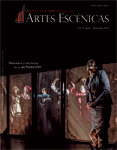Authors
Abstract
Objectives: To unravel the dramatic structure and the underlying format in the dramatic text “De-sastres y costuras. De-lirios y crisantemos”. To highlight the actuation levels –body-voice axis- in their staging. Scope: It is about giving continuity and monitoring to a very particular reading to the disaster produced by the Armero avalanche in 1985 which conclude with the drama, staging and a unique way to approach the work of acting, closely linked to the Aristotelian precepts contained in its Poetics, a work which outlines the structure and fundamental parts of the ancient Greek tragedy. Methodology: The essay intends to carry out a comparative reading –case study- about the play in the form of tragedy “De-sastres y costuras. De-lirios y crisantemos” from the Inverse Theater belonging to the research group Theater, Culture and Society from the Performing Arts Department from Universidad de Caldas. Conclusions: Reaching a categorization of playwriting and acting work of the Inverse Theatre group as a significant contribution to the research-creation processes of the Colombian theater movement.
References
Aristóteles. (1964). El arte poética. (Trad. José Goya y Muniain). Madrid: Espasa-Calpe S.A.
Braun, E. (1986). El director y la escena. Del naturalismo a Grotowski. Buenos Aires: Galerna.
Brecht, B. (1970). Escritos sobre teatro. (Selección de Jorge Hacker). Buenos Aires: Ediciones Nueva Visión.
Cerezo Arce, C. (2011) Gestalt, Cuerpo y Voz.Recuperado de htt p://www.escuelagestalt.com/wp-content/uploads/2011/11/Gestalt-Voz-y-Cuerpo.pdf
Esquilo. (1989). Tragedias completas. Bogotá:Editorial Panamericana.Hurtado Sáenz, L., Jaime, C.J, Molina Cruz,J.C., Vinasco Benavides, A., & Suárez Hincapié,
D.C. (2013). Teatro Inverso. Rastros sin rostro. De la creación a la investigación. Premio Nacional de Investigación 2013. Bogotá: Mincultura, Colección Pensar el Teatro.
Ionesco, E. (1996). Obras completas. Madrid:Aguilar.
Sánchez Q., C.A. (2013). Una lectura del desastre de Armero a la luz de la tragedia griega. Revista Colombiana de las Artes Escénicas,7, 152-176.
Shakespeare, W. (1986). El Rey Lear. Bogotá:Editorial Bedout, Colección Bolsilibros.
Stanislavski, C. (1980). El trabajo del actor sobre sí mismo. Buenos Aires: Editorial Quetz al.
Teatro Inverso. (2013). Cuatro miradas a un solo desastre. Revista Colombiana de las Artes Escénicas, 7, 53-75.
Tibón, Gutierre. (1994). Diccionario etimológico comparado de nombres propios de persona.México: Fondo de Cultura Económica.
Wikipedia. (2014). Calambur. Recuperado de htt p://es.wikipedia.org/wiki/Calambur
Yáñez Solana, M. (1995). El gran libro de los Nombres. Madrid: M. E. Editores.

 PDF (Español)
PDF (Español)
 FLIP
FLIP









